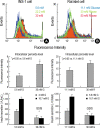A protective role for heme oxygenase-1 in INS-1 cells and rat islets that are exposed to high glucose conditions
- PMID: 16778382
- PMCID: PMC2729944
- DOI: 10.3346/jkms.2006.21.3.418
A protective role for heme oxygenase-1 in INS-1 cells and rat islets that are exposed to high glucose conditions
Abstract
Heme oxygenase-1 (HO-1) has been described as an inducible protein that is capable of cytoprotection via radical scavenging and the prevention of apoptosis. Chronic exposure to hyperglycemia can lead to cellular dysfunction that may become irreversible over time, and this process has been termed glucose toxicity. Yet little is known about the relation between glucose toxicity and HO-1 in the islets. The purposes of the present study were to determine whether prolonged exposure of pancreatic islets to a supraphysiologic glucose concentration disrupts the intracellular balance between reactive oxygen species (ROS) and HO-1, and so this causes defective insulin secretion; we also wanted to evaluate a protective role for HO-1 in pancreatic islets against high glucose levels. The intracellular peroxide levels of the pancreatic islets (INS-1 cell, rat islet) were increased in the high glucose media (30 mM glucose or 50 mM ribose). The HO-1 expression was induced in the INS-1 cells by the high glucose levels. Both the HO-1 expression and glucose stimulated insulin secretion (GSIS) was decreased simultaneously in the islets by treatment of the HO-1 antisense. The HO-1 was upregulated in the INS-1 cells by hemin, an inducer of HO-1. And, HO-1 upregulation induced by hemin reversed the GSIS in the islets at a high glucose condition. These results suggest HO-1 seems to mediate the protective response of pancreatic islets against the oxidative stress that is due to high glucose conditions.
Figures





References
-
- Ye J, Laychock SG. A protective role for heme oxygenase expression in pancreatic islets exposed to interleukin-1β. Endocrinology. 1998;139:4155–4163. - PubMed
-
- Wagener FA, da Silva JL, Farley T, de Witte T, Kappas A, Abraham NG. Differential effects of heme oxygenase isoforms on heme mediation of endothelial intracellular adhesion molecule 1 expression. J Pharmacol Exp Ther. 1999;291:416–423. - PubMed
-
- Pileggi A, Molano RD, Berney T, Cattan P, Vizzardelli C, Oliver R, Fraker C, Ricordi C, Pastori RL, Bach FH, Inverardi L. Heme oxygenase-1 induction in islet cells results in protection from apoptosis and improved in vivo function after transplantation. Diabetes. 2001;50:1983–1991. - PubMed
-
- Won KC. Oxidative stress in pancreatic islet beta-cells exposed to high glucose concentration. J Korean Diabetes Assoc. 2004;28:250–254.
Publication types
MeSH terms
Substances
LinkOut - more resources
Full Text Sources

